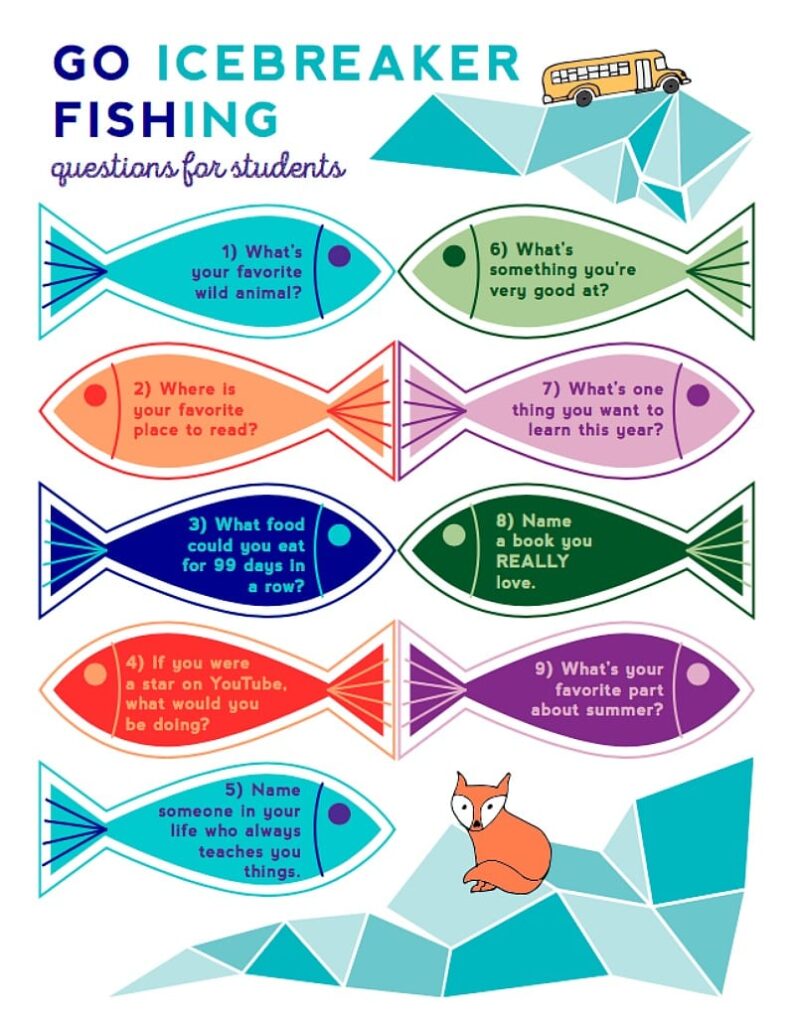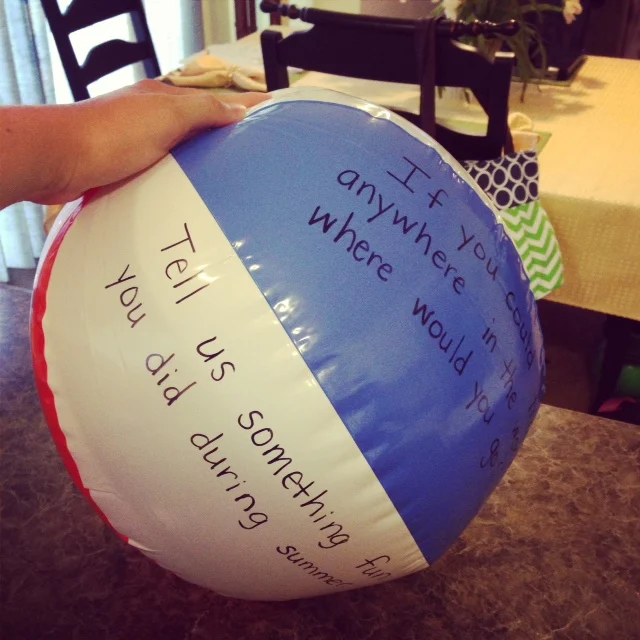It doesn’t matter what time of year it is, active icebreakers are always a good idea. Icebreakers refocus students, teach kids something new about each other (and themselves), and can be a great way to push kids out of their comfort zone.
We’ve collected active icebreakers from around the web to use at the beginning of the year, after winter break, and any old Tuesday you feel like you need to reset and break some ice.
1. Go icebreaker fishing
Use these printable questions in a fishing game that ends in students getting to know one another better. Print out one copy for your whole class, or break students into small groups.
2. Create a bucket list
Students work in groups to create a bucket list of things they want to do this school year (or in the final month of the school year). You can use the list to help with planning.
3. Make positive snowballs
Students write a positive quote, word of encouragement, or positive picture (for differentiated purposes) on a white piece of paper. They then crumple up their own sheet to make a “positive snowball.” Then, ready … aim… FIRE! Watch the positivity fly across the room both figuratively and literally. Have students sit in a circle to open and read the notes. After you’re done, don’t toss ’em. Instead, keep them in the classroom so students can reference them when they need a pick-me-up.
Learn more: Back to School Snowball Fight/The Teaching Kitchen
4. Lines and blobs
This game has students moving around freely until the teacher tells them to get in a line or a blob (small group) according to a category. Some prompts to use:
- Line up in birth order (youngest to oldest or oldest to youngest).
- Line up in birthday order from January to December.
- Line up according to how many siblings you have.
- Gather people who are wearing the same color as you.
- Line up in alphabetical order by last name.
- Gather people who come to school in a car, a bus, and on foot.
- Gather people who prefer movies or TV.
5. Compose a class chant
Have your students create a class chant. Not only does this instantly bring the group together, it also gives you a preview as to the unique personalities you’ll be seeing all year. Use the chant as a tool to call students in for recess, a call-and-response to signify quiet time, or even just for fun!
Here’s one example for inspiration:
6. Play the All My Friends game
Start by having your students form a circle. Stand in the middle and say, “All my friends like …,” and fill in the blank with anything you enjoy—Goldfish crackers, pizza, Rollerblading … anything! Any student who also enjoys the same thing as you has to switch a spot with another person in the circle. Much like musical chairs, whoever doesn’t have a spot goes in the middle and “All my friends …” starts all over again. This is a super-fast way to take note of your students’ interests.
7. Four Corners
Another sorting icebreaker, in this activity you label four corners or spaces in the room. Then, have students gather according to how they fall on a rating or question. For example, label the corners 1 through 4. Then, give students questions with four answers and have them sort themselves according to the number they choose.
8. Name your rose and thorn
This is a simple way to recap a summer vacation, weekend, or event at school. Your rose = your BEST part of summer vacation. Your thorn = something about summer vacation that was less than ideal. It’s a good way to get a quick read on your students. Plus, it’s good to share both positives and negatives.
9. Beach ball toss
If you’re looking for simple yet active icebreakers, try this one. Write icebreaker questions on a beach ball and have students toss the ball. They have to read and answer the question they see when they catch the ball. Do this as a whole-group icebreaker at the start of the year and revisit it in smaller groups as a movement activity later on. Here is a big list of icebreaker questions to help you fill in those beach balls.
Learn more: Getting To Know You Games/TeachStarter
10. Hop the line
Put a line (or imaginary line) down the middle of the room. Give students a question that has two options. Have students move to the side of the room that they agree with or prefer. Some prompts:
- Hot dogs or hamburgers?
- Ice cream or cake?
- Mountains or beach?
- Hot or cold?
- Fall or spring?
- Winter or summer?
- Airplane or car?
- Pencils or pens?
- College-ruled or wide-ruled notebook?
- Watch the movie or read the book?
11. Would You Rather?
Create two circles or spaces. Provide Would You Rather? questions and have students sort themselves according to the two choices. Check out this list of Would You Rather? prompts or use a video with ready-made prompts.
12. Learn names with movement
This is a fun and active way to get to know everyone’s name. One at a time, each student says their name and accompanies it with a physical motion. The rest of the group should mirror. Then you move on to the next person. This really gets students moving and opening up while learning the names of their classmates.
13. Classmate bingo
This is one of those classic active icebreakers for the classroom. Create bingo cards with prompts that students can use to ask each other questions and try to get bingo. Decide beforehand if you are playing for five in a row or a coverall.
14. State your opinion
Label four corners of the room: Strongly Agree, Agree, Disagree, Strongly Disagree. Students should start in the middle of the room or in their seats. Then the teacher reads a statement and students move to the corner of their room that represents their opinion on the topic. Topic examples might be “I love wearing uniforms to school” or “I believe cats are better than dogs.”
15. The human knot
The human knot is a great icebreaker for groups that need to start communicating, whether for the first time or the 50th.
16. Who started the motion?
Students stand in a circle. One student leaves the room for a moment. While out of the room, another student is chosen to “start the motion.” The selected student begins to move slowly while the rest of the students in the circle begin to follow along. The student in the hallway returns to the room and goes to the center of the circle. They have three chances to guess who started the motion. Repeat so several students get a turn.
Do you have more active icebreakers you use in the classroom? Share in the comments below!
Want more articles like this? Be sure to subscribe to our newsletters!




